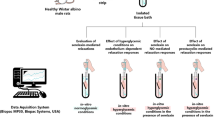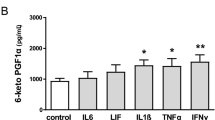Abstract
The regulatory role of nitric oxide (NO) in vaginal perfusion remains unclear. We used specific inhibitors of enzymes in the NO-cyclic GMP (NO-cGMP) pathway and investigated their effects on vaginal blood flow in the rabbit. NO synthase (NOS) activity was similar in both the proximal and distal rabbit vagina; whereas, arginase activity was 3.4-fold higher in the distal vagina. Intravenous administration of the NOS inhibitor L-NAME resulted in a 66% reduction in genital tissue oxyhemoglobin and a 53% reduction in vaginal blood flow. This attenuation occurred despite a 20–30% increase in systemic arterial pressure. The arginase inhibitor ABH caused a 2.1-fold increase in genital tissue oxyhemoglobin and 34% increase in vaginal blood flow. The guanylate cyclase inhibitor 1H-[1,2,4]oxadiazolo[4,3,-a]quinoxalin-1-one and the phosphodiesterase type 5 inhibitor sildenafil caused in a 37% reduction and a 44% increase in vaginal blood flow, respectively. These observations suggest that the NO-cGMP pathway is an important regulator of vaginal hemodynamics.
This is a preview of subscription content, access via your institution
Access options
Subscribe to this journal
Receive 8 print issues and online access
$259.00 per year
only $32.38 per issue
Buy this article
- Purchase on Springer Link
- Instant access to full article PDF
Prices may be subject to local taxes which are calculated during checkout






Similar content being viewed by others
References
Levin RJ . Sex and the human female reproductive tract—what really happens during and after coitus. Int J Impot Res 1998; 10(Suppl 1): S14–S21.
Wagner G . Aspects of genital physiology and pathology. Semin Neurol 1992; 12: 87–97.
Hoyle CH et al. Innervations of vasculature and microvasculature of the human vagina by NOS and neuropeptide-containing nerves. J Anat 1996; 188: 633–644.
Levin RJ . VIP, vagina, clitoral and periurethral glans—an update on human female genital arousal. Exp Clin Endocrinol 1998; 198: 61–69.
Ottesen B et al. Vasoactive intestinal polypeptide and the female genital tract: relationship to reproductive phase and delivery. Am J Obstet Gynecol 1982; 143: 414–420.
Ottesen B . Vasoactive intestinal polypeptide as a neurotransmitter in the female genital tract. Am J Obstet Gynecol 1983; 147: 208–224.
Ottesen B et al. Vasoactive intestinal polypeptide (VIP) provokes vaginal lubrication in normal women. Peptides 1987; 8: 797–800.
Palle C, Bredkjaer HE, Ottesen B, Fahrenkrug J . Vasoactive intestinal polypeptide and human vaginal blood flow: comparison between transvaginal and intravenous administration. Clin Exp Pharmacol Physiol 1990; 17: 61–68.
Cellek S, Moncada S . Nitrergic neurotransmission mediates the non-adrenergic non-cholinergic responses in the clitoral corpus cavernosum of the rabbit. Br J Pharmacol 1998; 125: 1627–1629.
Giraldi A et al. Morphological and functional characterization of a rat vaginal smooth muscle sphincter. Int J Impot Res 2002; 14: 271–282.
Ziessen T, Moncada S, Cellek S . Characterization of the non-nitrergic NANC relaxation responses in the rabbit vaginal wall. Br J Pharmacol 2002; 135: 546–554.
Cox JD, Kim NN, Traish AM, Christianson DW . Arginase–boronic acid complex highlights a physiological role in erectile function. Nat Struct Biol 1999; 6: 1043–1047.
Kim NN et al. Probing erectile function: S-(2-boronoethyl)-L-cysteine binds to arginase as a transition state analogue and enhances smooth muscle relaxation in human penile corpus cavernosum. Biochemistry 2001; 40: 2678–2688.
Kim N et al. Oxygen tension regulates the nitric oxide pathway. Physiological role in penile erection. J Clin Invest 1993; 91: 437–442.
Min K et al. Sildenafil augments pelvic nerve-mediated female genital sexual arousal in the anesthetized rabbit. Int J Impot Res 2000; 12(Suppl 3): S32–S39.
Vemulapalli S, Kurowski S . Sildenafil relaxes rabbit clitoral corpus cavernosum. Life Sci 2000; 67: 23–29.
Rees DD, Palmer RM, Moncada S . Role of endothelium-derived nitric oxide in the regulation of blood pressure. Proc Natl Acad Sci USA 1989; 86: 3375–3378.
Schwarzacher S, Raberger G . L-NG-nitro-arginine methyl ester in the anesthetized rabbit: venous vasomotion and plasma levels. J Vasc Res 1992; 29: 290–292.
Efron DT, Barbul A . Modulation of inflammation and immunity by arginine supplements. Curr Opin Clin Nutr Metab Care 1998; 1: 531–538.
Wu G, Morris SM . Arginine metabolism: nitric oxide and beyond. Biochem J 1998; 336: 1–17.
Hilliges M, Falconer C, Ekman-Ordeberg G, Johansson O . Innervation of the human vaginal mucosa as revealed by PGP 9.5 immunohistochemistry. Acta Anat (Basel) 1995; 153: 119–126.
Acknowledgements
This work was supported by Grants R01-DK 56846 and K01-DK02696 from the National Institute of Diabetes and Digestive and Kidney Diseases. We thank Drs David W Christianson and Hyunshun Shin (Department of Chemistry, University of Pennsylvania) for synthesizing and providing the arginase inhibitor ABH and Jerie McGrath-Cerqua for her administrative assistance.
Author information
Authors and Affiliations
Corresponding author
Rights and permissions
About this article
Cite this article
Kim, S., Jeong, SJ., Munarriz, R. et al. Role of the nitric oxide-cyclic GMP pathway in regulation of vaginal blood flow. Int J Impot Res 15, 355–361 (2003). https://doi.org/10.1038/sj.ijir.3901038
Received:
Revised:
Accepted:
Published:
Issue Date:
DOI: https://doi.org/10.1038/sj.ijir.3901038
Keywords
This article is cited by
-
Global prevalence of sexual dysfunction among women with metabolic syndrome: a systematic review and meta-analysis
Journal of Diabetes & Metabolic Disorders (2023)
-
Protein kinase enzymes in the human vagina—relation to key mediators of the cyclic AMP and cyclic GMP pathways
International Journal of Impotence Research (2017)
-
Expressions of vaginal endothelial nitric oxide synthase and phosphodiesterase 5 in female sexual dysfunction: a pilot study
International Urogynecology Journal (2017)
-
Implication of Cigarette Smoking and Cessation on Sexual Function in Men and Women
Current Sexual Health Reports (2014)
-
Pharmacological profiling of neuropeptides on rabbit vaginal wall and vaginal artery smooth muscle in vitro
British Journal of Pharmacology (2008)



